|
by Barbara Lynne Hare
I have lived on an airfield for over 25 years now, which is owned
by my father in . With my dad owning a 150 Cessna, and
him wanting the kids to learn how to fly, I decided to take up the challenge and get my
license, not to fly conventional aircraft but to fly ultralights.
The reasons were:
- Even with my dad owning a 150 Cessna I couldn't afford the cost of
training, fuel and maintenance.
- I wouldn't be flying in controlled airspace so much of the
conventional training I would have to take would be unnecessary.
Over the years I have accumulated over 400 hours of flight time,
in various ultralight aircraft, including the SeaRey, Cosmos Trike, Merlin, Coyote,
Buccaneer Amphibian, Challenger, Carrera, Explore, Bushmaster and the L'il Buzzard. Which
brings me to the point of this article, a flight report on the L'il Buzzard.
The
L'il Buzzard
The L'il Buzzard is a side by side seating two place ultralight,
designed from the ground up for a training environment. This is quite evident once you
climb into the over 40 inch wide cockpit. 40 inches is enough for two large pilots dressed
in snowmobile suits to sit comfortably in the cabin. (While this is nice it really isn't
necessary when the optional two speed heater is installed). A 6 ' 6" pilot can sit,
with a helmet on and not have his head hit on the overhead tubes, and with the seats
adjusted to the rear of six positions he has ample leg room to stretch out.
The control systems are
standard stick and rudder, with two sticks, and 4 rudder
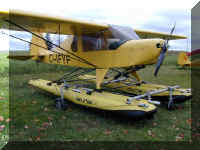 pedals.
Throttle controls are located on either side of the fuselage plus in the
center of the large instrument panel. Three throttles are standard, so
that students flying aircraft other than the L'il Buzzard which might
have center or left hand throttles can train with on a control system
that they will be comfortable with. Independent hydraulic brakes are
available, these are activated from two levers conveniently located
between the seats. Another standard feature is in cabin adjustable
elevator trim. The trim is found on the ceiling just in front of the
pilot. The trim control is connected via cable to the elevator where a
small hinged trim tab adjusts to relieve pressure on the stick and
control systems. This allows for long comfortable cross country flights,
without having to continually hold pressure on the control stick. pedals.
Throttle controls are located on either side of the fuselage plus in the
center of the large instrument panel. Three throttles are standard, so
that students flying aircraft other than the L'il Buzzard which might
have center or left hand throttles can train with on a control system
that they will be comfortable with. Independent hydraulic brakes are
available, these are activated from two levers conveniently located
between the seats. Another standard feature is in cabin adjustable
elevator trim. The trim is found on the ceiling just in front of the
pilot. The trim control is connected via cable to the elevator where a
small hinged trim tab adjusts to relieve pressure on the stick and
control systems. This allows for long comfortable cross country flights,
without having to continually hold pressure on the control stick.
The control system to the ailerons uses push pull tubes. These
are all located out in the open for ease of inspection and or repair. All of the control
push pull tubes are straight, and are manufactured from 4130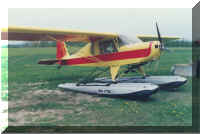 chromoly steel. This is
convenient for the owner, in case of damage he can repair the system himself, easily and
economically using materials purchased from any local aviation supply outlet. The rudder
and elevator cables are 1/8 cable which is the standard used in amateur built and most
conventional aircraft. These are also all out in the open - easy to inspect or replace. chromoly steel. This is
convenient for the owner, in case of damage he can repair the system himself, easily and
economically using materials purchased from any local aviation supply outlet. The rudder
and elevator cables are 1/8 cable which is the standard used in amateur built and most
conventional aircraft. These are also all out in the open - easy to inspect or replace.
The L'il Buzzard comes standard with a large windshield, two
doors and two rear tear drop shaped windows. The craft can be flown with the doors open or
closed, and they can be opened or closed in flight. Locking of the doors is accomplished
by lifting a small catch and clipping it into the wing or onto the fuselage. The lexan for
the doors and rear windows is flat so that replacement is just a quick trip to a local
supply store.
The fuselage is 5/8" chromoly steel tubing. The wing uses
"D" cell
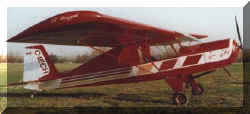 construction attached to an I beam spars. The ribs are aluminum, and
the craft is covered in standard aircraft covering materials. The steel suspension systems
uses a bungee cord shock system from a conventional "Cub" and is one of the
widest in the industry for great ground stability. Fuel is supplied to the 582 Rotax 65 HP
engine, 618, 75 HP, 912, 80HP or 914 115 HP engines, from a 10 gallon wing fuel tank with
an optional 10 gallon tank available. The fuel tank(s) have simple sight
fuel gauges construction attached to an I beam spars. The ribs are aluminum, and
the craft is covered in standard aircraft covering materials. The steel suspension systems
uses a bungee cord shock system from a conventional "Cub" and is one of the
widest in the industry for great ground stability. Fuel is supplied to the 582 Rotax 65 HP
engine, 618, 75 HP, 912, 80HP or 914 115 HP engines, from a 10 gallon wing fuel tank with
an optional 10 gallon tank available. The fuel tank(s) have simple sight
fuel gauges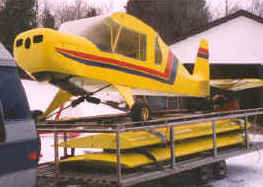 located inside the cabin. A very large storage area located
behind the seats allows you to stow a sleeping bag, tent, and
tie downs for those cross country outings.
located inside the cabin. A very large storage area located
behind the seats allows you to stow a sleeping bag, tent, and
tie downs for those cross country outings.
Another amazing thing about the L'il Buzzard is that it comes
already built, the owner can have it up and flying in less than 40 hours. After
installation of his engine and instruments. That's right I have watched as customers have
finished assembly of their kits. They show up with a helper on Friday morning and by
Sunday afternoon, the craft is ready to test fly.
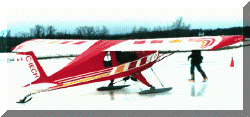 Not
only does the craft
make a great land plane but skis can be installed in less than 15 minutes. Remove the
wheels and slide the skis onto the axle stubs, and connect your safety cables and
bungees. Not
only does the craft
make a great land plane but skis can be installed in less than 15 minutes. Remove the
wheels and slide the skis onto the axle stubs, and connect your safety cables and
bungees.
The L'il Buzzard has float mounting attachment points welded right into the fuselage for
Full Lotus Floats and float installation using the kit supplied will take less than a day.
Performance
Pre-flighting the L'il Buzzard is a snap. The large engine compartment is easily accessible
by unlocking two over center latches on either side of the cowl. The Gull wing door
compartments open up to reveal the standard 582 Rotax engine.
Next you slide under the craft to check the motor mount, and
exhaust which are wide open for visual inspection. Then onto the adjustable Volkswagen
radiator used to cool the engine. While down here you inspect the bungees for the
suspension, wheels and bearings.
Next you open the door, clip it into the wing, and inspect the
control systems, brakes, leading and trailing edge bolts,
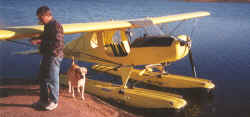 fuel shut offs and glance at the
fuel gauge. When finished you move to the strut attachment points, jury struts and run you
hand along the leading edge of the wing. Walking around the end of the wing you check you
aileron hinges and aileron attachment rod. fuel shut offs and glance at the
fuel gauge. When finished you move to the strut attachment points, jury struts and run you
hand along the leading edge of the wing. Walking around the end of the wing you check you
aileron hinges and aileron attachment rod.
Now work you way along the fuselage to the tail section, check
for any damage to the vertical fin, horizontal stab, and rudder. Checking all the pins for
cotter pins and the trim system. With this done you repeat the procedure for the other
side. Fueling the L'il Buzzard is easy - set the tank up on the wing and let the fuel
siphon into the wing tank. With the tank in the wing instead of over head, or in the
cockpit, no fuel is spilled onto the seats, and gas fumes are eliminated from the cabin
area.
Climbing into the L'il Buzzard takes a little getting use to. You enter from behind the
rear strut,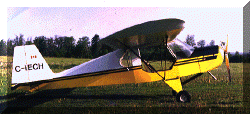 by sliding your head in and grabbing one of the tubes up by the ceiling, now lift using
your arm as you rotate your butt into the seat. Once inside you position the seat by
gently pulling out on a lever on the side of the seat, just like your car, and pulling
forward until the seat locks in the position you require. Now you do the safety belt up
and put on your helmet. With your helmet on and plugged into your intercom box you can
turn on the master switch and the two ignition switches. "Miss CT" is equipped
with a new engine monitoring gauge . The gauge welcomes you on board with a visual message
and then turns on its monitoring mode. You now push the primer in a couple of times and
hit the starter button, the engine comes to life. A female voice is heard "Warning
water temperature low" looking at the gauge you can see that the water temperature is
only 90 degrees, once you reach operating temperature 120 degrees you hit the monitor
switch and the gauge runs through the different instruments. EGT 1, EGT2, etc etc etc.
more about this gauge in a later issue.
by sliding your head in and grabbing one of the tubes up by the ceiling, now lift using
your arm as you rotate your butt into the seat. Once inside you position the seat by
gently pulling out on a lever on the side of the seat, just like your car, and pulling
forward until the seat locks in the position you require. Now you do the safety belt up
and put on your helmet. With your helmet on and plugged into your intercom box you can
turn on the master switch and the two ignition switches. "Miss CT" is equipped
with a new engine monitoring gauge . The gauge welcomes you on board with a visual message
and then turns on its monitoring mode. You now push the primer in a couple of times and
hit the starter button, the engine comes to life. A female voice is heard "Warning
water temperature low" looking at the gauge you can see that the water temperature is
only 90 degrees, once you reach operating temperature 120 degrees you hit the monitor
switch and the gauge runs through the different instruments. EGT 1, EGT2, etc etc etc.
more about this gauge in a later issue.
Arriving at the end of the runway, you use the manual select to
run through the instruments, and do a mag check. With everything within working parameters
you apply full throttle for take off. The L'il Buzzard springs to life. RPM for take off
hits 6450, the craft remains in a three point stance and in less than 150 feet you are
airborne. Looking at the VSI you see a climb rate of 700 feet a minute at 65 mph. as you
approach the center line of the runway you pull back on the stick, airspeed drops to 55
and the climb rate is just of 1,000 feet per minute. Dropping the nose a little airspeed
picks up to 65. You maintain 65 mph until you hit 2,000 feet. Setting out on a short cross
country to Baldwin you level the craft, and back the power down to 5800 RPM and adjust the
trim tab to release any pressure on the stick. At 5800 the airspeed sits at 80 mph.
Looking at the engine monitoring gauge you see that the outside airtemp is 78 degrees, and
note that it is a little warm in the cabin. This is easily fixed by adjusting the two
window vents located in either door, so that they blow directly on to you. As your flying
along a soothing voice is heard in your ears "all parameters normal". 18 minutes
later you arrive at Baldwin Airpark, during this time the craft has been flown totally
"hands off" with no adjustments required for trim on elevator or rudder.
Upon reaching the airpark you decide to do a dead stick landing.
Setting up into a standard circuit you shut the engine off on as soon as you enter the
down wind leg. A voice is heard "engine RPM low" looking up front you note that
the 3 blade IVO prop is stopped, but turns a little bit now and again. With the engine off
pressure is felt on the stick, so you pull the trim all the way back, the pressure is
relieved. With about 1500 feet of altitude you slow the craft down to 55 mph, this keeps
you up in the air but gives you little distance, you fly the downwind and base using this
speed. As you enter final you drop the nose a little - airspeed is now 65 mph and you are
able to cover a great deal of distance. You clear the hydro lines and then apply right
rudder and left aileron to side slip, "Miss C.T." drops like a rock in a pond at
about 25 feet you return to straight flight, and 10 you level her and at 5 you apply a
little bit of back pressure and "play" with the stick until she comes in and
lands in a nice three point stance. By applying both brakes you are able to stop in about
50 feet as you turn off to the side of the runway.
You fire C.T. up, taxi to the end of the runway and take off
again. Arriving at altitude you decide to try some turns. You lead with a little left
rudder and a little left stick, and then use the stick to control the angle of the turn,
once around you feed in opposite rudder and stick until your once again straight and
level. Next you decide to try a stall. From straight and level flight you slowly ease back
on the throttle, while app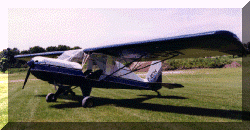 lying back pressure on the stick, as you hit 35 mph you have to work the
rudder pedals to keep the craft straight, with the engine at an idle and the stick back in
you stomach C.T. waddles like a duck but refuses to drop her nose. You climb to altitude
again, this time you back power down and then shut the engine off. Slowly you apply back
pressure on the stick until at 35 mph C.T. drops her nose, in a stall, you release
pressure and she immediately starts flying again. It's quite evident that the 172 sq ft of
wing really make this one very forgiving ultralight. You hit the starter button once more
and the 582 springs to life. lying back pressure on the stick, as you hit 35 mph you have to work the
rudder pedals to keep the craft straight, with the engine at an idle and the stick back in
you stomach C.T. waddles like a duck but refuses to drop her nose. You climb to altitude
again, this time you back power down and then shut the engine off. Slowly you apply back
pressure on the stick until at 35 mph C.T. drops her nose, in a stall, you release
pressure and she immediately starts flying again. It's quite evident that the 172 sq ft of
wing really make this one very forgiving ultralight. You hit the starter button once more
and the 582 springs to life.
Landing back at the field you pull in front of your
tie down , once out the plane you grab onto to the handle located on the rudder and pull
her back into her parking spot or you and your student can grab onto either one of the two
lifting handles located at the rear of the fuselage. You then tie her down using the rings
located at the ends of the struts.
|

 pedals.
Throttle controls are located on either side of the fuselage plus in the
center of the large instrument panel. Three throttles are standard, so
that students flying aircraft other than the L'il Buzzard which might
have center or left hand throttles can train with on a control system
that they will be comfortable with. Independent hydraulic brakes are
available, these are activated from two levers conveniently located
between the seats. Another standard feature is in cabin adjustable
elevator trim. The trim is found on the ceiling just in front of the
pilot. The trim control is connected via cable to the elevator where a
small hinged trim tab adjusts to relieve pressure on the stick and
control systems. This allows for long comfortable cross country flights,
without having to continually hold pressure on the control stick.
pedals.
Throttle controls are located on either side of the fuselage plus in the
center of the large instrument panel. Three throttles are standard, so
that students flying aircraft other than the L'il Buzzard which might
have center or left hand throttles can train with on a control system
that they will be comfortable with. Independent hydraulic brakes are
available, these are activated from two levers conveniently located
between the seats. Another standard feature is in cabin adjustable
elevator trim. The trim is found on the ceiling just in front of the
pilot. The trim control is connected via cable to the elevator where a
small hinged trim tab adjusts to relieve pressure on the stick and
control systems. This allows for long comfortable cross country flights,
without having to continually hold pressure on the control stick. chromoly steel. This is
convenient for the owner, in case of damage he can repair the system himself, easily and
economically using materials purchased from any local aviation supply outlet. The rudder
and elevator cables are 1/8 cable which is the standard used in amateur built and most
conventional aircraft. These are also all out in the open - easy to inspect or replace.
chromoly steel. This is
convenient for the owner, in case of damage he can repair the system himself, easily and
economically using materials purchased from any local aviation supply outlet. The rudder
and elevator cables are 1/8 cable which is the standard used in amateur built and most
conventional aircraft. These are also all out in the open - easy to inspect or replace. construction attached to an I beam spars. The ribs are aluminum, and
the craft is covered in standard aircraft covering materials. The steel suspension systems
uses a bungee cord shock system from a conventional "Cub" and is one of the
widest in the industry for great ground stability. Fuel is supplied to the 582 Rotax 65 HP
engine, 618, 75 HP, 912, 80HP or 914 115 HP engines, from a 10 gallon wing fuel tank with
an optional 10 gallon tank available. The fuel tank(s) have simple sight
fuel gauges
construction attached to an I beam spars. The ribs are aluminum, and
the craft is covered in standard aircraft covering materials. The steel suspension systems
uses a bungee cord shock system from a conventional "Cub" and is one of the
widest in the industry for great ground stability. Fuel is supplied to the 582 Rotax 65 HP
engine, 618, 75 HP, 912, 80HP or 914 115 HP engines, from a 10 gallon wing fuel tank with
an optional 10 gallon tank available. The fuel tank(s) have simple sight
fuel gauges located inside the cabin. A very large storage area located
behind the seats allows you to stow a sleeping bag, tent, and
tie downs for those cross country outings.
located inside the cabin. A very large storage area located
behind the seats allows you to stow a sleeping bag, tent, and
tie downs for those cross country outings. Not
only does the craft
make a great land plane but skis can be installed in less than 15 minutes. Remove the
wheels and slide the skis onto the axle stubs, and connect your safety cables and
bungees.
Not
only does the craft
make a great land plane but skis can be installed in less than 15 minutes. Remove the
wheels and slide the skis onto the axle stubs, and connect your safety cables and
bungees.
 fuel shut offs and glance at the
fuel gauge. When finished you move to the strut attachment points, jury struts and run you
hand along the leading edge of the wing. Walking around the end of the wing you check you
aileron hinges and aileron attachment rod.
fuel shut offs and glance at the
fuel gauge. When finished you move to the strut attachment points, jury struts and run you
hand along the leading edge of the wing. Walking around the end of the wing you check you
aileron hinges and aileron attachment rod. by sliding your head in and grabbing one of the tubes up by the ceiling, now lift using
your arm as you rotate your butt into the seat. Once inside you position the seat by
gently pulling out on a lever on the side of the seat, just like your car, and pulling
forward until the seat locks in the position you require. Now you do the safety belt up
and put on your helmet. With your helmet on and plugged into your intercom box you can
turn on the master switch and the two ignition switches. "Miss CT" is equipped
with a new engine monitoring gauge . The gauge welcomes you on board with a visual message
and then turns on its monitoring mode. You now push the primer in a couple of times and
hit the starter button, the engine comes to life. A female voice is heard "Warning
water temperature low" looking at the gauge you can see that the water temperature is
only 90 degrees, once you reach operating temperature 120 degrees you hit the monitor
switch and the gauge runs through the different instruments. EGT 1, EGT2, etc etc etc.
more about this gauge in a later issue.
by sliding your head in and grabbing one of the tubes up by the ceiling, now lift using
your arm as you rotate your butt into the seat. Once inside you position the seat by
gently pulling out on a lever on the side of the seat, just like your car, and pulling
forward until the seat locks in the position you require. Now you do the safety belt up
and put on your helmet. With your helmet on and plugged into your intercom box you can
turn on the master switch and the two ignition switches. "Miss CT" is equipped
with a new engine monitoring gauge . The gauge welcomes you on board with a visual message
and then turns on its monitoring mode. You now push the primer in a couple of times and
hit the starter button, the engine comes to life. A female voice is heard "Warning
water temperature low" looking at the gauge you can see that the water temperature is
only 90 degrees, once you reach operating temperature 120 degrees you hit the monitor
switch and the gauge runs through the different instruments. EGT 1, EGT2, etc etc etc.
more about this gauge in a later issue.  lying back pressure on the stick, as you hit 35 mph you have to work the
rudder pedals to keep the craft straight, with the engine at an idle and the stick back in
you stomach C.T. waddles like a duck but refuses to drop her nose. You climb to altitude
again, this time you back power down and then shut the engine off. Slowly you apply back
pressure on the stick until at 35 mph C.T. drops her nose, in a stall, you release
pressure and she immediately starts flying again. It's quite evident that the 172 sq ft of
wing really make this one very forgiving ultralight. You hit the starter button once more
and the 582 springs to life.
lying back pressure on the stick, as you hit 35 mph you have to work the
rudder pedals to keep the craft straight, with the engine at an idle and the stick back in
you stomach C.T. waddles like a duck but refuses to drop her nose. You climb to altitude
again, this time you back power down and then shut the engine off. Slowly you apply back
pressure on the stick until at 35 mph C.T. drops her nose, in a stall, you release
pressure and she immediately starts flying again. It's quite evident that the 172 sq ft of
wing really make this one very forgiving ultralight. You hit the starter button once more
and the 582 springs to life.